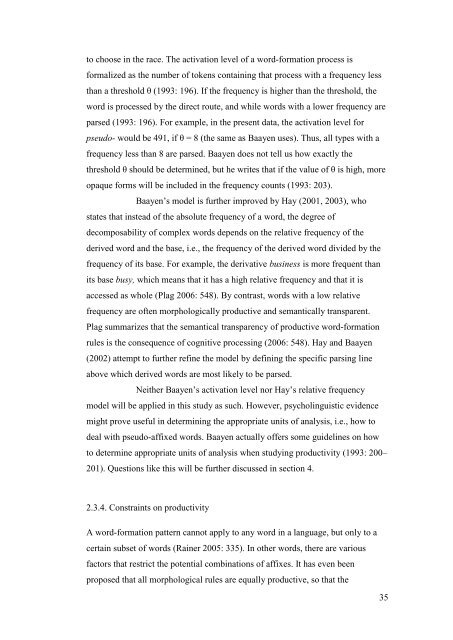The morphological productivity of selected ... - Helda - Helsinki.fi
The morphological productivity of selected ... - Helda - Helsinki.fi
The morphological productivity of selected ... - Helda - Helsinki.fi
Create successful ePaper yourself
Turn your PDF publications into a flip-book with our unique Google optimized e-Paper software.
to choose in the race. <strong>The</strong> activation level <strong>of</strong> a word-formation process is<br />
formalized as the number <strong>of</strong> tokens containing that process with a frequency less<br />
than a threshold θ (1993: 196). If the frequency is higher than the threshold, the<br />
word is processed by the direct route, and while words with a lower frequency are<br />
parsed (1993: 196). For example, in the present data, the activation level for<br />
pseudo- would be 491, if θ = 8 (the same as Baayen uses). Thus, all types with a<br />
frequency less than 8 are parsed. Baayen does not tell us how exactly the<br />
threshold θ should be determined, but he writes that if the value <strong>of</strong> θ is high, more<br />
opaque forms will be included in the frequency counts (1993: 203).<br />
Baayen’s model is further improved by Hay (2001, 2003), who<br />
states that instead <strong>of</strong> the absolute frequency <strong>of</strong> a word, the degree <strong>of</strong><br />
decomposability <strong>of</strong> complex words depends on the relative frequency <strong>of</strong> the<br />
derived word and the base, i.e., the frequency <strong>of</strong> the derived word divided by the<br />
frequency <strong>of</strong> its base. For example, the derivative business is more frequent than<br />
its base busy, which means that it has a high relative frequency and that it is<br />
accessed as whole (Plag 2006: 548). By contrast, words with a low relative<br />
frequency are <strong>of</strong>ten <strong>morphological</strong>ly productive and semantically transparent.<br />
Plag summarizes that the semantical transparency <strong>of</strong> productive word-formation<br />
rules is the consequence <strong>of</strong> cognitive processing (2006: 548). Hay and Baayen<br />
(2002) attempt to further re<strong>fi</strong>ne the model by de<strong>fi</strong>ning the speci<strong>fi</strong>c parsing line<br />
above which derived words are most likely to be parsed.<br />
Neither Baayen’s activation level nor Hay’s relative frequency<br />
model will be applied in this study as such. However, psycholinguistic evidence<br />
might prove useful in determining the appropriate units <strong>of</strong> analysis, i.e., how to<br />
deal with pseudo-af<strong>fi</strong>xed words. Baayen actually <strong>of</strong>fers some guidelines on how<br />
to determine appropriate units <strong>of</strong> analysis when studying <strong>productivity</strong> (1993: 200–<br />
201). Questions like this will be further discussed in section 4.<br />
2.3.4. Constraints on <strong>productivity</strong><br />
A word-formation pattern cannot apply to any word in a language, but only to a<br />
certain subset <strong>of</strong> words (Rainer 2005: 335). In other words, there are various<br />
factors that restrict the potential combinations <strong>of</strong> af<strong>fi</strong>xes. It has even been<br />
proposed that all <strong>morphological</strong> rules are equally productive, so that the<br />
35
















